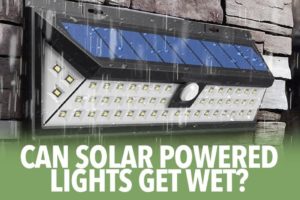Last updated on March 24th, 2022
If your outdoor light is labeled “weatherproof,” then it should be able to withstand splashing by rain and abuse by foreign objects. However, if you live in an area with harsh inclement weather and a high propensity for flooding, then you might desire something a little bit stronger. This might involve waterproofing the lights to make them utterly impregnable to water and dust. We purpose to answer the question ‘ how to waterproof outdoor lights’ in this content.One of the easiest ways to waterproof outdoor lights is to apply an extra silicon seal (caulk) during installation. There are other methods such as choosing high IP-rated fixtures or using light shields. In addition to a watertight lamp, you also want the outlet to be secure.
Today, we look at different ways to reinforce and further waterproof your outdoor lights and connections.
Table of Contents
Benefits of waterproofing outdoor lights
Here are some of what you stand to gain by waterproofing your outdoor lights.
You can Use the Lights at Any Time
Waterproofing your outdoor lights adds weather resistance capability to your building. This means you can use your lights every time regardless of the weather condition.
Protects Your Outdoor Lights from Getting Wet
Using lights that are”wet-rated” or built for outdoor use means the lights can be directly exposed to water without getting wet or having the inner components compromised. This doesn’t only ensure the bulbs last long but also guarantees your safety.
Prevent Electrical Shocks
Electricity and water do not mix. Thus without waterproofing your outdoor lights, you run the risk of electrical shocks whenever it rains. These shocks are very dangerous.
Ensure Your Lights Last Longer
Water can also corrode the components or wires inside the lamp, which puts people at risk and causes the lights to degrade faster. Waterproofing the lights make them last longer.
How to waterproof outdoor lights – Methods
Method 1 – Caulking
Use water-resistant silicone caulk to create an all-season moisture seal around where the light meets with the backplate.
These are what you require for this procedure.
- Caulk
- Moist fabric or cloth to clean the surface before caulking
- Ladder for lights that are positioned high up
- Blanket to receive caulk droppings
- Utility knife to guide the caulk, so it doesn’t go off course
- Paper towels to remove unprofessional-looking caulk blobs
- Water to add finishing touches
Here are the steps to follow to caulk outdoor lights
- Clean the surface
Start by cleaning the area you wish to caulk using the damp cloth. This is very important to ensure the efficacy of the sealant. Caulk is most potent when used on a clean surface.
- Before caulking
Don’t apply the caulk yet. Set up every other thing you need. Get your blanket (preferably an old blanket) and spread it beneath the light or place where you want to caulk.
Your step ladder should also be ready if the light is beyond normal reach. Keep a pile of paper towels close, as well as your utility knife. Your bowl of water should be ready too.
- Apply the caulk
Now, fit the caulk into an applicator gun, and start caulking. Make sure you apply the caulk to a specific area you’ve determined beforehand. Do it gently!
A lot of times, water gets in through the slight gaps between the light and backplate (or mounting board). So it’s a good idea to start here. Apply the caulk steadily in one continuous flow, and whenever it goes off-course, use your utility knife to set it back into position. Start from the top, and then go all the way to the bottom.
- Smoothen Out the Caulk
After caulking, dip your fingers into the bowl of water you have around. Then with your wet finger, gently touch the caulk and press it down to smoothen out. Do this repeatedly until you have gone around the caulked area.
- Clean the Spilled Caulk
Now get rid of any spilled caulk following the instructions that come with the caulk tube.
https://www.youtube.com/watch?v=PNHgX9rUB0E
Method 2 – Hang the Lights on Stakes (Christmas String Lights)
Before going through with this method, make sure you’re not working with any live wire. Your extension cord should be unplugged.
Test the GFCI outlet, and ensure it’s working correctly.
What you will need:
- Pack(s) of waterproof gaskets (rain block is recommended)
- Extension cord (15-amp or more). Cords with contractor ratings work best.
- The outdoor lights that need waterproofing
- Ground stakes to keep the lights elevated from the ground
- Pack(s) of lighting waterproof kit
Steps:
- We begin by making a connection between the gaskets and male connectors of the string lights. So place the former on the latter and press to lock tightly. Ensure all outlets are closed.
- Next, repeat the step above for the female outlets to seal off the back of the light plug.
- Now apply gaskets to the male outlets and plug the second string light into the first. By doing this, you can connect several string lights linearly and safely.
- Next, snap off the third prong and position a gasket on it. Press firmly to join with the female connection to seal the last string light.
- The extension cord should be hanged on a stake above and be positioned upside down together with the outlets. This will ensure it’s safe from rain and flood.
- The lights should also be hanged on stakes, trees, fences, or other elevated positions above ground level.
Other Ways to Waterproof Outdoor Lights
Consider Opting for Solar Lights
Solar lights work great outdoors and are perfect for pathways. They don’t require wiring like standard string lights or LED lights, so there’s no risk of wire damping or the creation of short circuits.

They are completely sealed, so water can’t penetrate.
Unfortunately, solar lights are not always bright enough and may not last all through the night. However, some units come with batteries, which ensure they last longer.
Use Outdoor Lights with at least IP65 Ratings
The best way to ensure your lights survive irregular weather changes is to use lights built for such conditions.
IP rating represents how waterproof and dustproof a light fixture is. It is usually represented by two numbers: the first one denotes durability against water, while the second number deals with how well the light can handle abrasion.
IP rating might not mean much for indoor lights, but for outdoor lights, it’s essential. Usually, the higher the IP rating, the better.
Outdoor lights rates IP65 are great for outdoor use. It’s even better if it’s IP67 or IP68. It simply tells you that the light will survive in heavy rains.
Use Light Shields
Another way to protect your outdoor lights from the elements is to use light shields. These are small transparent boxes that you can fit over the lamps and seal them so water won’t penetrate.
If your existing outdoor lights don’t have a favorable IP rating, then you can buy shields if you can’t afford to replace the entire lighting. Outdoor lights usually have an IP rating of 65 which means it’s weatherproof and can withstand the elements.
Fixtures with a lower rating might not survive for long when exposed to moisture, dust, or dirt.
Use Extension Cords that are Rated Outdoors
In addition to watertight bulbs or lamps, you should also go for outdoor-rated extension cords.
Avoid using indoor extension cords. They are light and are not designed to withstand the harsh conditions outside. They can easily get damaged by water.
Instead, use outdoor-rated cords, especially when installing a temporary light fixture outside the home.
Conclusion
We will draw the curtains here.
Now, if after waterproofing your lights, they still short out during or after a heavy downpour, DON’T go out until the ground is dried off. Or you risk getting electrocuted.
That said, I expect everything to be safe if you’ve followed one or more of the methods above.

I bought some solar lights… in mason jars.. but some leak. Can I put saran wrap on the solar panel under the sealing ring?